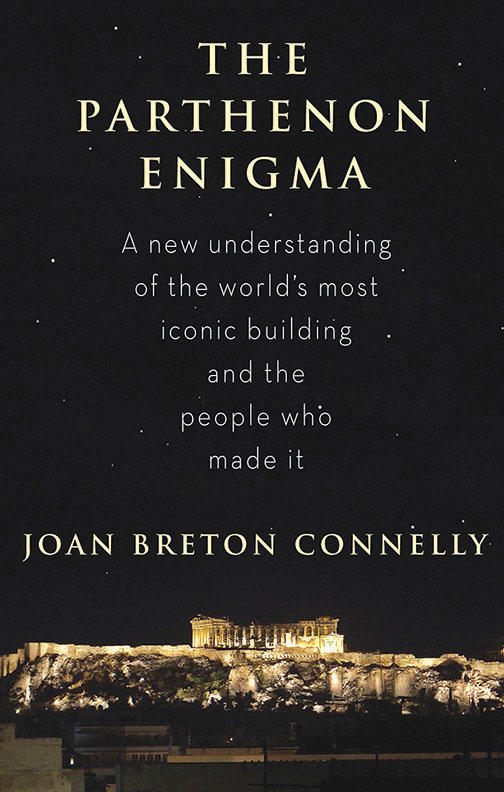A glorious, 524-foot-long scene of prancing animals and toga-clad Greeks, the Parthenon frieze is among the most famous sculptures in the world. Most of it is now in the British Museum in London.
Scholars long have debated the meaning of the frieze: Does it show, as many of us were taught in school, a religious ritual that wound up the steep sides of the Acropolis every four years, back in the fifth century B.C. when the structure was built?
In The Parthenon Enigma: A New Understanding of the World’s Most Iconic Building and the People Who Made It (Alfred A. Knopf), New York University professor of classics and art history Joan Breton Connelly ’76 makes a startling claim: The frieze doesn’t show that peaceable “Panathenaic procession” at all, but instead depicts a harrowing legendary event — the decision of mythical King Erechtheus to sacrifice his three daughters in order to save long-ago Athens from military ruin.
As proud heirs to Greek democracy, many people view the Parthenon as among our highest “standards of what it means to be civilized,” says Connelly. Thus it has “suffered from the distortions that tend to befall icons.” The Parthenon Enigma seeks to overturn these longstanding assumptions, giving us the temple as its builders actually understood it.
For Connelly, the eureka moment came when she was reading fragments of a lost play by Euripides. They explicitly link the story of Erechtheus’ sacrifice to later religious rites at the Parthenon. These papyrus fragments only recently came to light, having been discovered accidentally as wrappings on an Egyptian mummy.
Connelly offers a new interpretation of the culminating scene of the Parthenon frieze, in which a man and a child together hold a blanket-like cloth. Advocates of the longstanding Panathenaic explanation say this is the peplos, the sacred robe of Athena that was carried in the religious parade. The man, they believe, is a priest. No, Connelly argues, he is Erechtheus; the child is his youngest daughter, shown with her burial shroud. Nearby stand two young women, who Connelly believes are the older daughters who likewise will be sacrificed, as the Oracle of Delphi grimly had commanded. The frieze “tells the tale of the city’s founding hero,” says Connelly, and shows that we are descended from a civilization that glorified human sacrifice as practiced in its mythical past. This fits uneasily with what Connelly calls the “nostalgic” Western view of ancient Athens, its “idealizing vision of a city inhabited by philosophical rationalists.”
Many scholars are unwilling to relinquish the traditional explanation of the frieze, in part, she argues, because they are uncomfortable equating high-minded Athens with human sacrifice. “I’ve especially written this book for the young,” Connelly says. “It’s future generations you write for, people who have not yet made up their minds.”
The Ancient Greek Hero in 24 Hours by Gregory Nagy: “I am very big on bringing the classics to the broadest possible public, and he does that.”














1 Response
Thomas D. Logie ’72
9 Years AgoContinuing Human Sacrifice
Joan Breton Connelly ’76 is probably right about the Parthenon frieze, judging from other ancient instances of child or human sacrifice (Princetonians, Jan. 8). The Iliad mentions Agamemnon sacrificing his daughter in order to obtain favorable winds to invade Troy. When I was a student, I thought this legendary, but I now suspect that there was truth behind this, just as there was a real Trojan War that inspired the Iliad. Archeology is showing that we tend to discount ancient history too much.
Human sacrifice was known among the Druids and among Central American peoples centuries after the Parthenon was built. Earlier, Moses had written about how God spared Isaac and by example showed that human sacrifice is wrong as early as 2000 BC or so. Roughly 14 centuries after Abraham, child sacrifice reappeared in the times of Ahaz and Manasseh of Judah, having been established in the Northern Kingdom earlier. In Sparta children regularly were exposed, and this continued in the Roman Empire after the death of Christ.
Today, methods are different but outcomes are similar. We sacrifice children to our desires instead of to bloodthirsty gods. Our technology enables us to reach into the womb, rather than sacrifice after birth. In many parts of the world, most of those sacrificed are women because of expensive dowries. There are different reasons in the United States and in Europe. But despite technological progress, we as a societal or human whole are uncomfortably like the ancient Greeks, as well as others who practiced child sacrifice. “Those who do not know history are doomed to repeat it.”